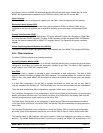
HONEYWELL Aerospace Electronic Systems Page 19
Use or disclosure of information on this page is subject to the restrictions on the title page of this document.
A758 Level Application Functions
A Airline/AOC Applications and ATS Messages
ACARS End System
ARINC 620: AOC
ARINC 620: AAC
ARINC 623: ATIS
ARINC 623: PDC
ARINC 623: Oceanic Clearance
B +ATS Applications Support and Flight Deck I/F Compatible w/ Non-Radar
ARINC 622: ACARS Convergence Function (ACF)
ARINC 622: Air Traffic Facilities Notification (AFN)
ARINC 745: Automatic Dependent Surveillance - Advanced (ADS-A)
RTCA/DO219: Controller/Pilot Data Link
Communications (CPDLC)/ATS Datalink (ATS DL)
C + ATN Application Support & Flight Deck I/F Compatible w/ Radar / Enroute
Operations
ACARS/ATN Gateway
Context Management (CM)
Flight Information Services (FIS)
D + ATS Applications & Flight Deck I/F Compatible w/ Terminal & Surface
Operations
ATN Systems Management
Uplink Processing
The Mark III CMU can receive uplink messages for routing to other LRUs (e.g., FMC, CMC, ACMS) or for
internal processing. Messages can originate from either AOC or ATC ground systems. The Mark III CMU
routes messages to an end system based upon the ACARS label and optional sublabel in the message as
defined in the routing table. Although there is a default routing table, the user can modify the table via the
AMI.
The flight crew will be notified of uplink display messages destined for the Mark III CMU by a visual and
potentially an aural alert, depending upon the alert level specified in the uplink message decoding definition.
An aural alert is typically a bell or chime while a visual alert is typically an EICAS message.
An uplink display message destined for the Mark III CMU will normally be placed in the new-messages log
until selected for viewing by the flight crew. An uplink message could be defined to be placed in the new-
messages log and be printed or just be sent to the printer. Uplinks can also result in an automatically
downlinked message containing the information requested by the uplink. The action taken for the uplink as
well as the screen and print format for the message is dependent upon the message definition specified by
the user in the AMI. Further, the display (or print format) of the uplink message can include any aircraft
parameters defined in the FIDB and specified in the AMI.
When selected for viewing, a new message may have crew actions required for the message. If crew action
is required, associated ACCEPT and REJECT buttons will exist on the datalink display.


















